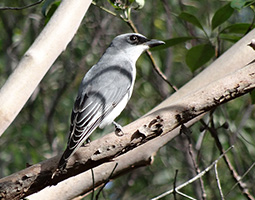Coracina novaehollandiae
Description

The Black-faced Cuckoo-shrike is a large bird of 30-36cms which is widespread and commonly found in wooded habitat with the exception of rainforests. They have white underparts, blue-grey back, wings and tail and a black face and throat. Young birds look similar to the adult but the black facial mask is reduced to an eye stripe and are often confused with the White-bellied Cuckoo-shrike which is 26~28cms and smaller.
Adaptations
- The nest is small for the size of the bird and constructed by both parents. It resembles a shallow saucer made from sticks and bark held together by cobwebs
- The young spend 21 days in the nest with the breeding season between August to February
- The bird makes different calls which include ‘shri-lunnk’, ‘plee-urk’, 'kree' and 'skair’
Feeding relationships
- What I eat: they feed mainly on insects and other invertebrates with some fruits and seeds in their diet. They search for food in the air, on the ground, amongst foliage and in the air
- What eats me: carpet pythons, lace monitors
Interesting facts
Cuckoo-shrikes are named because their feature pattern is similar to cuckoos and their beak shape looks like a shrike but they belong to neither group. The flight of the Cuckoo-shrike is unusual as they flap their wings only a few times then glide with them beside their side for a couple of seconds. While this occurs the birds elevation decreases until they flap again. On landing the bird repeatedly shuffles its wings, moving them up and down which has resulted in the alternative name of shufflewing’.